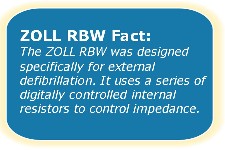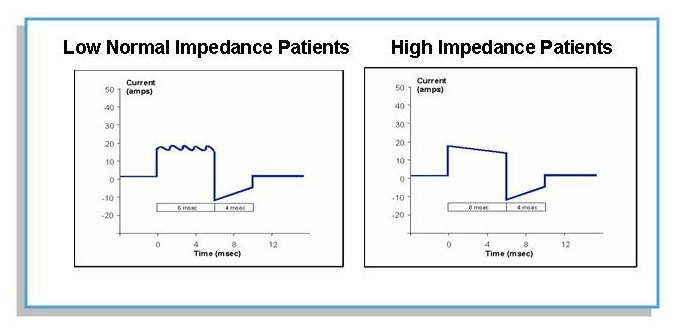Biphasic Technology - Impedance
New Control for Patient Impedance
Patient impedance directly affects the amount of current that is delivered to the heart. While average patient impedance is usually reported to be around 75 ohms, it can fluctuate anywhere from 35 ohms to 150 ohms. This variation can make it difficult to prescribe the right "dose" of electrical therapy.
The ZOLL Rectilinear Biphasic™ waveform is different from all other biphasic waveforms in the way it controls total impedance. The ZOLL RBW uses a series of digital resistors inside the box, which can add anywhere from 0 to 70 ohms of equipment resistance to patient impedance. These resistors serve two important functions: first, they compensate for variations in patient impedance to control "total" impedance; and second, they keep average current delivery relatively constant over the first phase of the shock.
How Does RBW Impedance Control Work?
An impedance test pulse of 250 µsec is applied prior to shock delivery. During this test pulse, all 70 ohms of equipment resistors are engaged and the amount of current flowing through the patient is measured. Once the patient impedance is calculated, equipment resistance is either maintained or decreased to adjust for patient impedance, so the total impedance (equipment + patient) stays relatively constant.

ZOLL RBW Impedance Control

The only exception to this feature is for high impedance patients. In this case, the patient needs all the current possible, and equipment resistors are disengaged for the entire shock. The waveform for this group of patients will look more like a typical biphasic truncated exponential waveform, but even these patients are still getting more current with the ZOLL RBW than with any other device, and the duration remains fixed at 10 ms.
Read on to uncover the unique advantages of ZOLL's Rectilinear Biphasic waveform:
Principles of Electricity
More Current at 200 J than other biphasic waveforms at 360 J
New Control for Patient Impedance
Optimal Duration for Defibrillation Shocks
Superior for Cardioversion of Atrial Fibrillation
Superior for Defibrillation of Ventricular Fibrillation
Superior for Defibrillation of Out-of-Hospital Cardiac Arrest
Pediatric Biphasic Recommendations
Bibliography
